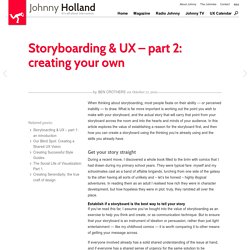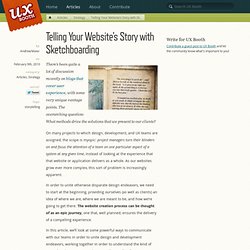

Storyboarding & UX – part 2: creating your own. When thinking about storyboarding, most people fixate on their ability — or perceived inability — to draw.

What is far more important is working out the point you wish to make with your storyboard, and the actual story that will carry that point from your storyboard across the room and into the hearts and minds of your audience. In this article explores the value of establishing a reason for the storyboard first, and then how you can create a storyboard using the thinking you’re already using and the skills you already have. Get your story straight During a recent move, I discovered a whole book filled to the brim with comics that I had drawn during my primary school years. They were typical fare: myself and my schoolmates cast as a band of affable brigands, lurching from one side of the galaxy to the other having all sorts of unlikely and – let’s be honest – highly illogical adventures. Establish if a storyboard is the best way to tell your story What’s your point? Roll camera End well. User Experience Design Sketches. One of the many challenges in creating new user experiences that do not yet fully exist or have nothing equivalent to make a comparison with, is that often getting someone, especially a client, to buy into an idea can be difficult.

Another challenge that is often faced when designing a user experience is that you cannot always have access to the environments to build up a coversation with a team of people working on a project, so they can all see the vision as a whole experience. Experiences often are emotional and happen over a course of time, in many locations and touch points. This is where working with storyboards and animated vignettes really helps in communicating ideas. This particular example, is a sample of some of the work that went into a series of vignettes that were produced to help Microsoft to internally describe some application of touch and gesture technology in common environments. Telling Your Website's Story with Sketchboarding. There’s been quite a lot of discussion recently on blogs that cover user experience, with some very unique vantage points.

The overarching question: What methods drive the solutions that we present to our clients? On many projects to which design, development, and UX teams are assigned, the scope is myopic: project managers turn their blinders on and focus the attention of a team on one particular aspect of a system at any given time, instead of looking at the experience that that website or application delivers as a whole. Sketchboards: Discover Better + Faster UX Solutions. The sketchboard is a low-fi technique that makes it possible for designers to explore and evaluate a range of interaction concepts while involving both business and technology partners.

Unlike the process that results from wireframe-based design, the sketchboard quickly performs iterations on many possible solutions and then singles out the best user experience to document and build upon. It’s what we do well Designers love the “breakthrough moments” in a working relationship. Those times when you suddenly reveal a picture of a solution that really nails the problem and gives everyone on the team a reason to cheer. Such moments bring together many of the most valuable capabilities of a designer, as follows: The trouble is that these moments are all too rare on normal design and development projects. Where wireframes fear to tread The wireframe—default design tool of most UX professionals—is a significant part of this problem. Wireframes constrain your creativity. 52 Weeks of UX. The user experience is made up of all the interactions a person has with your brand, company, or organization.

This may include interactions with your software, your web site, your call center, an advertisement, with a sticker on someone else’s computer, with a mobile application, with your Twitter account, with you over email, maybe even face-to-face. The sum total of these interactions over time is the user experience. The interaction designer plans for these moments. Part of their responsibility is to make all interactions positive, and includes aspects of the software, the copy-writing, the graphics, layout, flows, physical experiences.
It’s a shame when one part of the experience is top notch and another is dreadful. User experience spans multiple practices. Web designers, traditionally secure in the role of page creators, now have a wider purview. Anyone Can Sketch.